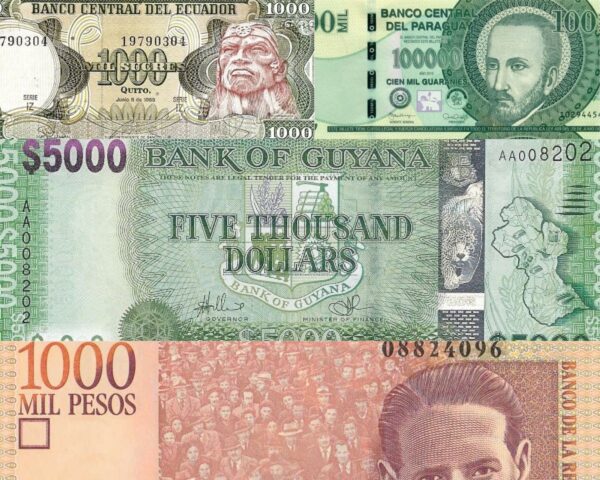When doing a cross-border transaction or investing in another country, it’s important to know the value of the currency of the country you want to invest in.
In case you’re considering an investment, in the fourth largest continent, this article highlights the five weakest currencies in South America after we highlighted the strongest legal tender in the same continent under review.
The term “weakest” is used in the context of the value of currencies in South African countries against the US dollar.
Although the US Dollar is not the strongest currency in the world, it remains the major currency used for international trade and in the global market.
In one of our articles, we demystified the composition of the countries in South America and their currencies, here we placed each of the 12 currencies in the politically independent countries side by side against the USD and rate them based on the exchange rate using the USD as the base.
Note:
Their many factors that may change the value of a currency at the foreign exchange market, as such, the exchange of the currencies in this article is subject to change.
As such, this post will be updated from time to time to reflect the latest exchange of the currencies in the continent which is nicknamed the “continent of extreme”
What are the worthless currencies in South America?
Argentine peso is the official legal tender in Argentina; the Surinamese dollar is the official currency of Suriname; Peru uses Sol as a means of exchange; the Uruguayan peso is the legal tender of Uruguay; the Bolívar is the official currency in Venezuela, while Sucre is synonymous with Ecuador.
Others include the Guyanese dollar in Guyana; in Paraguay, it’s Guaraní; you will have to have some Colombian peso in Colombia to transact; Boliviano is the official currency in Bolivia; the Chilean peso is to Chile, while the Brazilian real is Brazil’s legal tender.
Of all the above currencies, which of them perform poorly against the US dollars in the forex market?
Let’s take a look…
Venezuelan Bolivar Fuerte or VEF (no.1)
The most worthless currency in South America is the official currency of Venezuela. The country’s economy has been battered by repeated hyperinflation and the poor monetary policies of the government.
Some of the key factors that made VEF weak include 1) the country’s uncontrolled borrowing which plunged it into debt, 2) emptying the country’s foreign reserves.
At a time, Venezuelan people prefer to hold the USD than the local currency. Currently, 1USD is worth VEF437,834.93 at the official rate, it could be more than this at the black market rate.
Ecuador Sucre (no.2)
Until March 9, 2000, Sucre was the official currency of Ecuador. That was when President Gustavo Noboa signed a law passed by Congress, to replace the sucre with the United States dollar.
The move is seen by economist experts as dollarization of the Ecuadorian economy as one of the moves to escape the poor value of its currency.
At the time, the president made the US dollar the official rate, 1USD would get 25,000 sucres at the official exchange rate.
USD is still being used for the smallest transactions, Sucre coins are still in circulation.
Based on the disparity between the Sucre and the USD, we consider the Ecuadorian sucre as the second weakest currency in South America.
So, as s tourist visiting Ecuador, you don’t need to worry about possessing Sucre, you can visit the troubled country with your USD.
No stress, no issue about the exchange rate. You can even buy over 24,000 ECU with just a USD as souvenirs. That’s worthless the Sucre is against the USD.
Note: The financial crisis of 1998-1999, plunged the sucre into the ocean causing 67 per cent loss in its foreign exchange value. The country never recovered.
Paraguay Guaraní (no.3)
Next to the Sucre is Guaraní, the official currency of Paraguay. Inflation has also dealt a bad blow on the Paraguayan economy making its currency lose value at the forex market.
Note: The law that made Guaraní the official currency was passed on October 5, 1943, to replace the peso. Guaraníes were first issued in 1944.
Between 1960 and 1985, the guaraní was pegged to the United States dollar at ₲126 = US$1, the story has changed today.
At the time of publication, a USD is worth ₲6,888.53, making Paraguay’s currency one of the weakest legal tender among the South American currencies.
Colombian Peso (no.4)
The Colombian peso uses the USD symbol $ or COL$ to differentiate it from other pesos- and dollar-denominated currencies around the world.
Colombian economists and other financial analysts may not forget the high inflation of the 1970s and 1980s in the South American country.
Till now, the Colombian Peso is one of the worthless currencies on that continent.
Chilean Peso (no.5)
Like Colombia, Chile also uses the USD symbol ($). Peso has been in circulation since 1975. To avoid any form of confusion, you are most likely to find people using CLP$ for clarification.
In March 2021, 1USD was valued at CLP$730, but today (February 28, 2022), the Chilean Peso has been weakened more to CLP$803.89 to one USD.
Recap
| S/N | Conversion using US dollar as the quote currency | Value in local currency |
| 1 | 1USD to Venezuelan Bolivar | VEF437,834.93 |
| 2 | 1USD to Ecuador Sucre | 24,925.12 Sucres |
| 3 | 1USD to Paraguayan Guaraní | ₲6,888.53 |
| 4 | 1USD to Colombia Peso | COL$3,898.12 |
| 5 | 1USD to Chilean Peso | CLP$803.89 |
There are more than a dozen other worthless currencies around the world, but in the South American countries, the five aforementioned currencies have little value at the forex market against the US dollar and other powerful currencies in the world.


